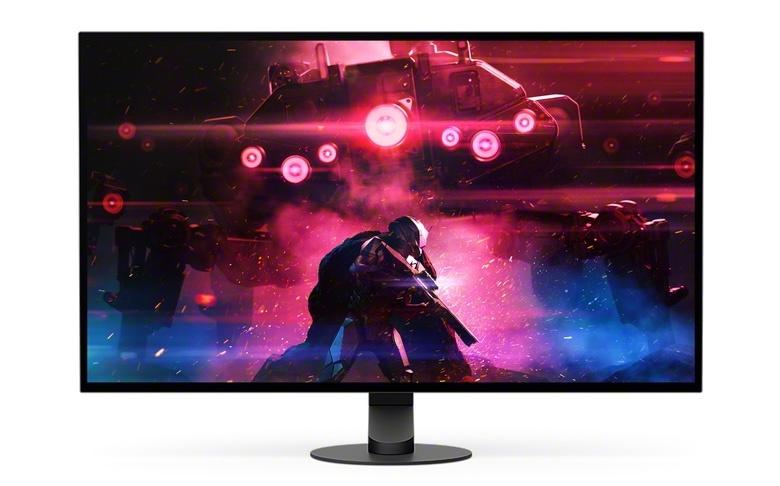Sony has taken the wraps off two new additions to its ‘INZONE’ range of gaming monitors, both aimed at the relatively serious end of the market. The new flagship M10S model, in fact, has been created in tandem with the renowned Fnatic esports team to deliver all the features and performance required to enjoy a truly pro-grade level of gaming performance for multiplayer FPS games.
The new M9 II may be a step-down from the M10S, but it’s still designed to be good enough to meet the needs of what Sony terms ‘Core Competitive Gamers’, as well as more casual/mainstream gamers who prefer single player adventure or RPG games.
The INZONE M10S
The first premium feature of the M10S is its use of a self-emissive OLED screen, where each pixel makes its own light for the ultimate in local contrast precision. Even better, the M10S uses the relatively new Micro Lens Array take on OLED technology, where tiny lenses behind the screen help to focus the light better to boost brightness. Thanks to this, Sony claims that the M10S is capable of hitting spectacular brightness peaks (on a 3% of screen area HDR window) of 1300 nits. Even though the monitor is actually rated more conservatively at True Black 400 by VESA’s DisplayHDR certification program.
The M10S’s 27-inch OLED screen also covers 98.5% of the DCI-P3 colour spectrum usually used for HDR graphics at a 10-bit level of gradation, and carries a native QHD 1440p resolution with a rapid 0.03ms grey to grey response time that should be easily good enough to eradicate motion blur from your gaming experience.
Perhaps the single most eye-catching specification of the M10S’s panel, though, is that it supports native refresh rates all the way up to 480Hz, for an incredibly fluid, smooth performance with the few graphics cards and games able to take advantage of such a cutting edge feature.
The Fnatic Pro gamer team, meanwhile, really do seem to have had considerable influence on the M10S’s features and design; it’s definitely not just a marketing-only collaboration. So, for instance, the INZONE M10S has a Tournament Ready mode that sees the monitor presenting pictures in a 24.5-inch size (with a 1:1 resolution of 1332p) that perfectly represents the screen sizes used in professional gaming competitions. It’s also possible for pro gamers to select lower resolutions, including 1080p, if that’s what they’re familiar with, and the actual position of the smaller Tournament Mode window in the M10S’s full screen can be centre- or bottom-aligned.
Since the M10S uses a premium OLED panel, moreover, the small black bars that will surround the 24.5-inch Tournament Mode image will looksas black as the physical frame around the screen, meaning they won’t distract you from the image you need to be zoned in on.
Fnatic has also been involved in the development of two unique picture modes dedicated to FPS gaming. FPS Pro+ optimises the clarity of the picture using OLED’s uniquely fast response times and contrast, while an FPS Pro mode essentially emulates the image characteristics of the LCD monitors usually used in tournament conditions.
I mentioned earlier that the M10S has a black surround, which introduces us to the fact that it’s quite a departure in design terms from Sony’s previous INZONE monitors. Those took their style cues from Sony’s PlayStation 5 console, but this time round Sony wants there to be no confusion about the fact that the M10S is very much focused on serious PC gaming.
A color change is far from the only thing that’s different about the M10S’s design, though. It sits on a circular base, for starters, that’s just 159mm in diameter, leaving loads of room on a desktop for gamers to place mouse mats and keyboards exactly where they like them. The monitor can be rotated fully round through 360 degrees on its base too, while the screen has been designed so that its centre of gravity always sits right above the centre of the base to ensure it never feels unstable despite sitting on such a small foot.
The screen can easily be angled, tilted, swivelled, raised and lowered, too, through an impressive range of movement, while the self-emissive OLED panel supports much wider viewing angles than most LCD screens.
Connectivity, meanwhile, continues to impress, as an HDMI 2.1 port is joined by a 2.1-spec DisplayPort capable of handling those enormous potential frame rates. There’s also variable refresh rate support in the NVIDIA G-SYNC and VESA formats, while a slick game-focused menu provides access to a series of gaming aids, including black level adjustment and the option to place a custom target recticle at the centre of the screen.
The M10S has just been announced as the official tournament monitor for Apex Legends Global Series tournaments starting from the Championship schedule to take place in Japan in January, and is set to go on sale in October, priced at $1,099/£1,199/€1,349.
The M9 II
With its greater focus on RPG and adventure games, it’s not surprising to find Sony’s INZONE M9 II monitor switching to a full 4K UHD resolution for its 27-inch screen, so that it can bring out every detail from all those gorgeously rendered landscapes. It also shifts from an OLED to an IPS LCD panel, enabling it to deliver a higher typical brightness level certified to the DisplayHDR 600 level (though it only claims a peak light level of 750 nits that’s a fair bit down on the 1300 nits peak claimed – albeit only in small areas – by the M10S).
As you’d hope of a premium LCD monitor, the M9 II uses a full array with local dimming panel, meaning that its LEDs are placed directly behind the screen rather than around its edges, and that different zones of those lights can output different amounts of light for any given image frame to improve contrast. Apparently there are 96 separate dimming zones in play – the same number used in the original M9 – driven by local dimming technology taken from Sony’s Bravia TV division.
The M9 II’s refresh rate tops out at 160Hz, slightly up on the 144Hz rate of the original M9, while its supported color gamut drops slightly from that of the M10S to a still impressive 95% of the DCI-P3 spectrum.
Inevitably the M9 II’s response time isn’t quite as speedy as that of the M10S OLED, but at 1ms it’s still very respectable for an LCD monitor. There’s support for VRR in the NVIDIA G-Sync and VESA standards too, and it even gets the same HDMI 2.1 and DisplayPort 2.1 connections you get with the M10S. Though unlike the M10S, the DisplayPort cable provided with the monitor only meets the 1.4 spec.
The M9 II’s design again features a compact, space-saving base on which the screen can rotate through a full 360 degrees, and again the screen and stand support tilting, swivelling and height adjustment to make long play sessions as comfortable as possible.
The M9 II also offers something the M10S doesn’t: Perfect For PlayStation 5 support. Meaning a PS5 can detect that it’s attached to this monitor and auto optimize its HDR tone mapping accordingly, while the monitor can detect whether a connected PS5 is outputting video or a game and adjust its image preset accordingly. To be clear, Sony still sees the M9 II very much as a PC monitor; it’s not just intended to be a PS5 display. But it’s kind of nice to see two parts of Sony’s technology world working together.
The M9 II is out in October, priced at $799/£899/€999.
—
Related Reading
Sony Bravia 9 Mini LED TV First Look – The Future Is (Very) Bright
Sony Unveils Radical New TV And Soundbar Range For 2024
Sony Inzone M9 Gaming Monitor Review: All Things Bright And Beautiful
Read the full article here






